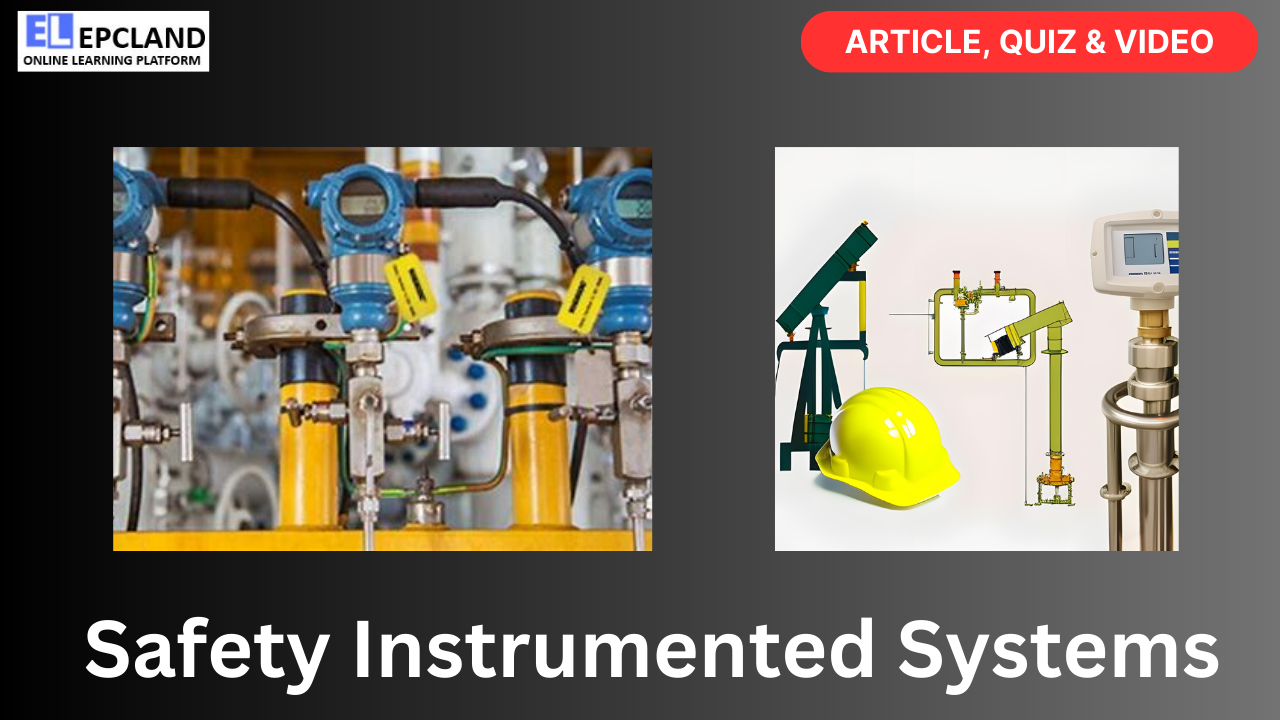The Oil and Gas Industry is known for its complex and high-risk operations. Safety is paramount in this industry, and achieving it requires the implementation of robust safety measures. One such crucial component is Safety Instrumented Systems (SIS), which play a vital role in mitigating risks and ensuring the safety of personnel, equipment, and the environment. In this article, we will delve into the world of Safety Instrumented Systems, their significance, components, applications, and the evolving landscape in the Oil and Gas Industry.
Table of Contents
Do not miss the detailed course 7 Modules of Piping Codes & Standards
Enrollment link
Introduction to Safety Instrumented Systems (SIS)
What are Safety Instrumented Systems?
Safety Instrumented Systems, commonly referred to as SIS, are a set of independent instruments and controls used to safeguard industrial processes by taking actions to prevent or mitigate hazardous events. These systems are designed to detect abnormal conditions, such as overpressure, high temperature, or toxic gas leaks, and initiate predetermined actions to bring the process to a safe state or prevent catastrophic incidents.
Significance of SIS in the Oil and Gas Industry
In the Oil and Gas Industry, where operations involve the handling of flammable substances, high pressures, and extreme temperatures, the consequences of accidents can be catastrophic. SIS are the last line of defense, designed to prevent or minimize the impact of potentially dangerous situations. They provide a safety net when other protective layers fail, thereby safeguarding human lives, the environment, and costly assets.
Components of Safety Instrumented Systems
SIS comprise several key components that work together to ensure safe operations:
1. Sensors
Sensors are the front-line detectors of abnormal process conditions. These instruments monitor parameters such as temperature, pressure, level, flow, and gas concentration. When a sensor detects a hazardous condition, it sends a signal to the SIS to take appropriate action.
2. Logic Solver
The logic solver is the brain of the SIS. It receives signals from sensors, processes the data, and determines whether to initiate a safety action. This decision-making process is based on pre-defined safety logic and algorithms.
3. Final Elements
Final elements are responsible for executing the safety action decided by the logic solver. These can include shutdown valves, blowout preventers, isolation dampers, and other devices that can quickly stop or divert the flow of hazardous substances.
4. Alarms and Indicators
SIS include alarms and indicators to alert operators about the activation of safety measures. These warnings help operators take additional actions or evacuate if necessary.
How Safety Instrumented Systems Work
The operation of Safety Instrumented Systems can be understood through the following sequence of events:
1. Hazard Detection
Sensors continuously monitor the process for hazardous conditions. When a parameter exceeds a predefined safety threshold or deviates from safe operating limits, the sensor detects the hazard.
2. Signal Transmission
The sensor sends a signal to the logic solver, indicating the detected hazard. This signal contains crucial information about the nature and severity of the abnormal condition.
3. Safety Logic and Decision-Making
The logic solver receives the signal and assesses the situation based on predefined safety logic and algorithms. It determines whether to initiate a safety action and, if so, what action to take.
4. Safety Action
If the logic solver decides that a safety action is required, it sends a signal to the final elements, which promptly carry out the action. For example, a valve may close to isolate a hazardous process.
5. Alarm and Notification
Simultaneously, alarms and indicators are activated to inform operators and personnel about the ongoing safety action. This allows them to respond accordingly, such as initiating an emergency shutdown or evacuation procedures.
6. Verification and Testing
Safety Instrumented Systems undergo rigorous testing and verification to ensure their reliability. Regular functional tests, proof tests, and inspections are conducted to confirm that the SIS will perform as intended when needed.
Applications of Safety Instrumented Systems in the Oil and Gas Industry
Safety Instrumented Systems find wide-ranging applications in the Oil and Gas Industry, ensuring the safe operation of various processes and activities:
1. Emergency Shutdown Systems (ESD)
One of the primary applications of SIS in the industry is Emergency Shutdown Systems (ESD). ESD systems are designed to quickly and safely shut down entire process units or specific equipment in the event of hazardous conditions. For example, if a fire is detected on an offshore oil rig, the ESD system will initiate actions to prevent the spread of the fire and protect personnel.
2. Fire and Gas Detection Systems
SIS play a crucial role in fire and gas detection. They are equipped with sensors that detect the presence of combustible gases, smoke, or high temperatures. When a fire or gas leak is detected, the SIS triggers alarms, activates fire suppression systems, and initiates emergency shutdown procedures.
3. Overpressure Protection
In oil and gas processes, overpressure can lead to equipment failure or catastrophic explosions. SIS are used to monitor pressure levels and activate pressure relief systems or isolation valves to prevent overpressure incidents.
4. High-Integrity Pressure Protection Systems (HIPPS)
HIPPS are specialized SIS designed to protect pipelines and equipment from overpressure. They are often used in critical applications such as offshore platforms, where rapid isolation of high-pressure pipelines is essential to prevent major accidents.
5. Process Safety Interlocks
Process safety interlocks are safety systems that enforce a sequence of operations to prevent unsafe conditions during startup, shutdown, or maintenance activities. They ensure that specific conditions are met before allowing certain actions to occur.
Advantages and Disadvantages of Safety Instrumented Systems
Safety Instrumented Systems offer several advantages in enhancing safety and mitigating risks in the Oil and Gas Industry. However, they also come with certain disadvantages and challenges. Let’s examine these in the following table:
Do not miss the detailed course 7 Modules of Piping Codes & Standards
Enrollment link
| Advantages | Disadvantages/Challenges |
|---|---|
| 1. Enhanced Safety: SIS provide a critical layer of protection against hazardous events, reducing the likelihood of accidents and their consequences. | 1. Complex Design: Designing and implementing SIS can be complex, requiring expertise in safety engineering and rigorous documentation. |
| 2. Rapid Response: SIS can respond quickly to abnormal conditions, minimizing the time it takes to mitigate a hazard and prevent escalation. | 2. Maintenance Demands: SIS components require regular maintenance and testing to ensure their reliability, which can be resource-intensive. |
| 3. Risk Reduction: By preventing or mitigating incidents, SIS reduce the overall risk associated with oil and gas operations, protecting human lives and the environment. | 3. Costs: The initial investment and ongoing operational costs of SIS can be significant, impacting project budgets. |
| 4. Compliance: SIS help organizations comply with safety regulations and international standards, ensuring that operations meet legal and industry requirements. | 4. Integration Challenges: Integrating SIS with existing control systems and processes can be challenging and may require significant engineering effort. |
| 5. Reliability: When properly designed and maintained, SIS are highly reliable and can function effectively in harsh operating conditions. | 5. Cybersecurity Risks: With increased connectivity, SIS are vulnerable to cyberattacks, necessitating robust cybersecurity measures. |
| 6. Safety Culture: Implementing SIS fosters a safety-conscious culture within organizations, emphasizing the importance of safety in all activities. | 6. Human Error: Like any system, SIS can be susceptible to errors in design, operation, or maintenance if not managed carefully. |
Evolving Landscape: Challenges and Future Trends
1. Cybersecurity
With the increasing integration of digital technologies, SIS are becoming vulnerable to cyber threats. Protecting SIS from cyberattacks is a growing challenge that requires robust cybersecurity measures to maintain their integrity and reliability.
2. Functional Safety Standards
The Oil and Gas Industry relies on international functional safety standards such as IEC 61511 and IEC 61508 to guide the design and operation of Safety Instrumented Systems. Compliance with these standards is crucial for ensuring the effectiveness of SIS.
3. Remote Monitoring and Diagnostics
Advancements in IoT and cloud-based technologies are enabling remote monitoring and diagnostics of SIS. This trend allows for real-time assessment of SIS health and performance, reducing downtime and improving overall safety.
4. Artificial Intelligence and Machine Learning
The industry is exploring the use of artificial intelligence and machine learning algorithms to enhance the reliability of SIS. These technologies can analyze vast amounts of data to predict failures and optimize maintenance schedules.
5. Enhanced Training and Competency
The industry recognizes the importance of well-trained personnel in maintaining and operating SIS. Training programs and competency assessments for SIS operators and maintenance personnel are on the rise.
Conclusion
Safety Instrumented Systems are the unsung heroes of the Oil and Gas Industry, silently working to protect lives, the environment, and valuable assets. Their role in preventing and mitigating hazardous events cannot be overstated. As technology advances and safety standards evolve, SIS will continue to play a pivotal role in ensuring the safety and sustainability of the industry.
In this article, we’ve explored the significance of Safety Instrumented Systems, their components, working principles, applications in the Oil and Gas Industry, and provided an overview of their advantages and disadvantages. Additionally, we’ve touched on the evolving landscape of SIS, including cybersecurity challenges, functional safety standards, remote monitoring, AI, and the importance of training.
As the industry continues to push the boundaries of exploration and production, the importance of Safety Instrumented Systems as a safety net for unforeseen events remains constant, making them an integral part of the industry’s future.
FAQs
1. What is the primary purpose of Safety Instrumented Systems (SIS) in the Oil and Gas Industry?
Safety Instrumented Systems are designed to prevent or mitigate hazardous events in the Oil and Gas Industry. Their primary purpose is to protect human lives, the environment, and valuable assets by taking automatic actions when abnormal or dangerous conditions are detected.
2. How do Safety Instrumented Systems differ from other safety measures in the Oil and Gas Industry?
SIS are independent and dedicated systems that provide a last line of defense. Unlike other safety measures, they are designed to function even when other protective layers fail. They have a specific focus on rapid hazard detection and automated responses to minimize the consequences of incidents.
3. What are some common applications of Safety Instrumented Systems in the industry?
SIS have diverse applications, including Emergency Shutdown Systems (ESD), fire and gas detection, overpressure protection, high-integrity pressure protection systems (HIPPS), and process safety interlocks. These systems are used to prevent or mitigate fires, gas leaks, overpressure incidents, and other potentially catastrophic events.
4. How are Safety Instrumented Systems maintained and tested to ensure their reliability?
Safety Instrumented Systems require regular maintenance and testing to ensure they function as intended. This includes functional tests, proof tests, and inspections. Additionally, organizations follow international standards and guidelines, such as IEC 61511, to establish maintenance and testing protocols.
5. What are the challenges associated with implementing Safety Instrumented Systems, and how can they be addressed?
Implementing SIS can be complex, requiring expertise in safety engineering and careful planning. Challenges include integration with existing systems, cybersecurity risks, and cost considerations. To address these challenges, organizations must invest in proper design, training, and ongoing maintenance while following industry standards and best practices.
Do not miss the detailed course 7 Modules of Piping Codes & Standards
Enrollment link
Recommended courses (Published on EPCLand)
- Basics of Piping Engineering
- Piping Layout Engineering
- Piping Material Engineering
- Piping Stress Analysis
- Complete Course on Piping Engineering
- Material Requisitions
- Piping Material Specifications
- Valve Material Specifications
Don’t miss the published articles on following:
| Industrial Applications with Link | Industrial Applications with Link |
| Corrosion Monitoring Instruments | Safety Instrumented Systems |
| Instrumentation in Renewable Energy | Safety Relief Valves |
| Orifice Plate in the Oil & Gas Industry | Well Test Instruments |
| Wellhead Pressure and Temperature Gauges | Wireless Instrumentation in Oil & Gas Projects |
Related Video
Attempt Quiz
Question 1:
What is the primary purpose of Safety Instrumented Systems (SIS) in oil & gas projects?
Explanation: The primary purpose of Safety Instrumented Systems (SIS) in oil & gas projects is to prevent and mitigate accidents by taking safety-critical actions in response to hazardous conditions.
Question 2:
What is the typical architecture of a Safety Instrumented System (SIS)?
Explanation: A typical architecture for a Safety Instrumented System (SIS) often involves a dual-channel or redundant configuration to enhance reliability and fault tolerance.
Question 3:
What is the Safety Integrity Level (SIL) used for in SIS design?
Explanation: The Safety Integrity Level (SIL) is used in Safety Instrumented System (SIS) design to assess and ensure the system’s safety level for preventing accidents.
Question 4:
What is a Safety Instrumented Function (SIF) in SIS terminology?
Explanation: A Safety Instrumented Function (SIF) in SIS terminology refers to a critical safety task performed by the Safety Instrumented System (SIS) to prevent accidents.
Question 5:
What is the purpose of a Safety Instrumented System (SIS) in a shutdown scenario?
Explanation: The purpose of a Safety Instrumented System (SIS) in a shutdown scenario is to safely shut down the process in emergency situations to prevent accidents.



